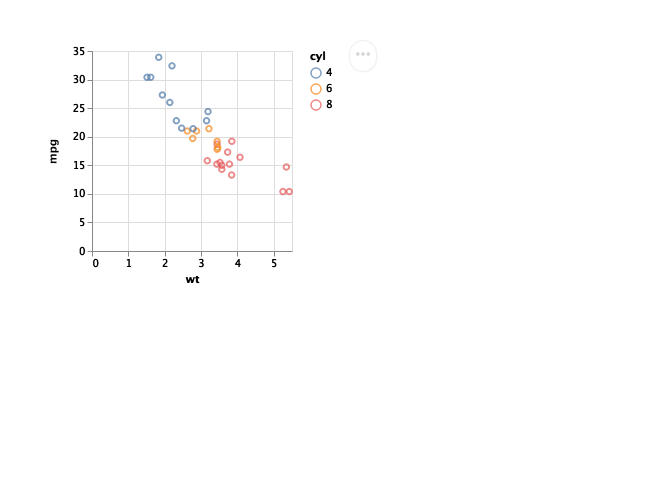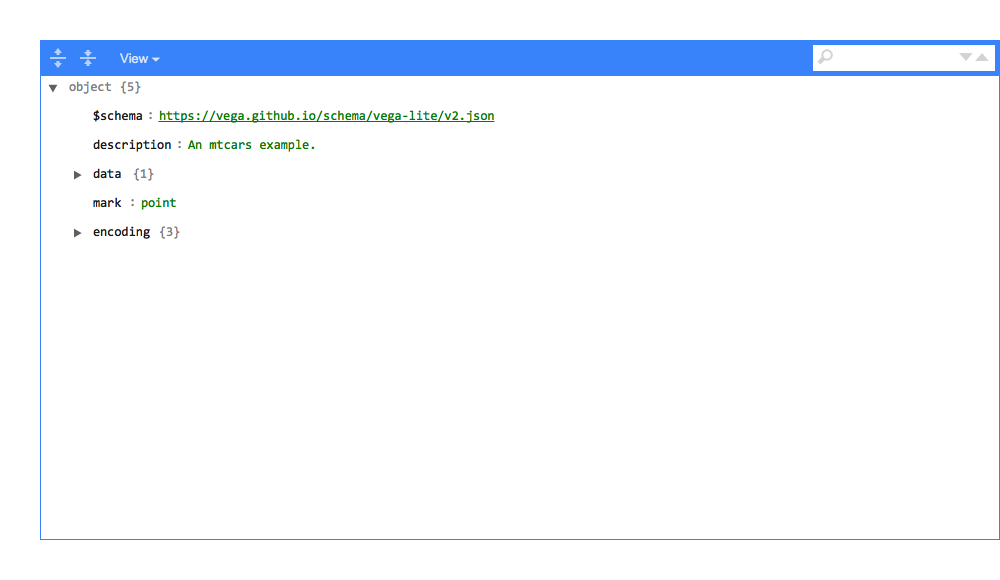The goal of vegawidget is to render Vega-Lite and Vega specifications into htmlwidgets. Its ambition is to be a low-level interface to the Vega(-Lite) API, such that other packages can build upon it to offer higher-level functions to compose Vega(-Lite) specifications. This is the key difference with the vegalite package; this package provides a but minimal interface to Vega-Lite.
You can install vegawidget from GitHub with:
# install.packages("devtools")
devtools::install_github("vegawidget/vegawidget")An interactive tutorial is available at shinyapps.io.
Vega(-Lite) specifications are just text, formatted as JSON. However, in R, we can use lists to build such specifications:
library("vegawidget")
spec_mtcars <-
list(
`$schema` = vega_schema(), # specifies Vega-Lite
description = "An mtcars example.",
data = list(values = mtcars),
mark = "point",
encoding = list(
x = list(field = "wt", type = "quantitative"),
y = list(field = "mpg", type = "quantitative"),
color = list(field = "cyl", type = "nominal")
)
) %>%
as_vegaspec()The as_vegaspec() function is used to turn the list into a vegaspec;
a good many of the functions in this package are built to support, and
render, vegaspecs:
spec_mtcarsIf you are reading this document on the GitHub code site, it is further
rendered into a PNG. In the background, the vegaspec print-method
converts the vegaspec to JSON, using vw_as_json(), then renders it as
an htmlwidget using vegawidget().
If you wish to examine a vegaspec, you may use the vw_examine()
function, which is a thin wrapper around the jsonedit() function from
the listviewer package.
vw_examine(spec_mtcars)If you wish to deploy a vegaspec to be rendered on bl.ocks.org, you can do that, provided you have a GitHub account.
vw_create_block(spec_mtcars)Similarly, if a block has a .json file with a JSON specification, you
can retrieve and put into a
vegaspec:
spec_new <- vw_retrieve_block("ijlyttle/06a512525fbe7a96e1a2028e1871b61c")This package provides functions to render Vega(-Lite) specifications; although it provides some helpers, it dos not provide higher-level functions to build specifications. Rather, this is left to other packages. Even though you can use its functions directly, you are invited to import and re-export them for use in your package.
Accordingly, this package offers a templating function,
use_vegawidget(), to help you integrate vegawidget functions into your
package. This function is used to import and re-export vegawidget
functions
for the altair package.
- Alicia Schep has been instrumental in guiding the evolution of the API.
- Bob Rudis and the vegalite package provided a lot of the inspiration for this work, providing a high-level interface to Vega-Lite.
- The Altair developers, for further popularizing the notion of using a programming language (Python) to create and render Vega-Lite specifications.
- The Vega-Lite developers, for providing a foundation upon which the rest of this is built.
Contributions are welcome, please see this guide. Please note that this project is released with a Contributor Code of Conduct. By participating in this project you agree to abide by its terms.


